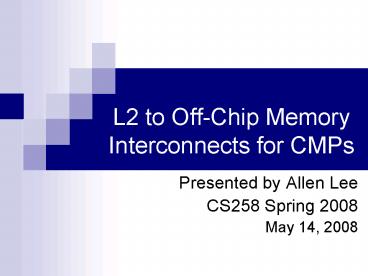L2 to OffChip Memory Interconnects for CMPs PowerPoint PPT Presentation
1 / 18
Title: L2 to OffChip Memory Interconnects for CMPs
1
L2 to Off-Chip Memory Interconnects for CMPs
- Presented by Allen Lee
- CS258 Spring 2008
- May 14, 2008
2
Motivation
- In modern many-core systems, there is significant
asymmetry between the number of cores and the
number of memory access points - Tileras multiprocessor has 64 cores and only 4
memory controllers - PARSEC benchmarks suggest that off-chip memory
traffic increases with the number of cores for
CMPs - We explore mechanisms to lower latency and power
consumption for processor-memory interconnect
3
Tilera Tile64
x5
4
Tilera Tile64
- Five physical mesh networks
- UDN, IDN, SDN, TDN, MDN
- TDN and MDN are used for handling memory traffic
- Memory requests transit TDN
- Large store requests, small load requests
- Memory responses transit MDN
- Large load responses, small store responses
- Includes cache-to-cache transfers and off-chip
transfers
5
Tapered Fat-Tree
- Good for many-to-few connectivity
- Fewer hops ? Shorter latency
- Fewer routers ? Less power, less area
- Root nodes directly connect to memory controller
- Replace MDN mesh network with two tapered
fat-tree networks - One for routing requests up
- One for routing responses down
6
Tile64 with Tapered Fat Tree
7
Memory Model
- Directory-based cache coherence
- Directory cache at every node
- Off-chip directory controller
- Tile-to-tile requests and responses transit the
TDN - Off-chip memory requests and responses transit
the MDN
8
TDN and MDN Traffic for L2 Read Misses
9
Synthetic Benchmarks
- Statistical simulation
- Model benchmarks from PARSEC suite
- Based on off-chip traffic for 64-byte cache-line
for 64 cores
Working Set Size
Small
Large
Sharing
More Less
10
(No Transcript)
11
Breakdown of Average Latency
- Latency of memory intensive applications
dominated by queuing delay. - Benchmarks with little off-chip traffic save on
transit time.
12
Power Modeling
- Orion power simulator for on-chip routers from
Princeton University - Models switching power as sum of
- Buffer power
- Crossbar power
- Arbitration power
- Specify parameters
- Activity factor, number of input and output
ports, virtual channels, size of input buffer,
etc.
13
Tilera MDN Routers
14
Tree Routers
15
Parameters
- 100 nm CMOS process
- VDD 1.0V
- Clock Frequency 750 MHz
- 32-bit flit width
16
(No Transcript)
17
(No Transcript)
18
Conclusion
- Physical design of the tapered fat-tree is more
difficult - The TFT topology can reduce memory latency and
power dissipation for many-core systems

